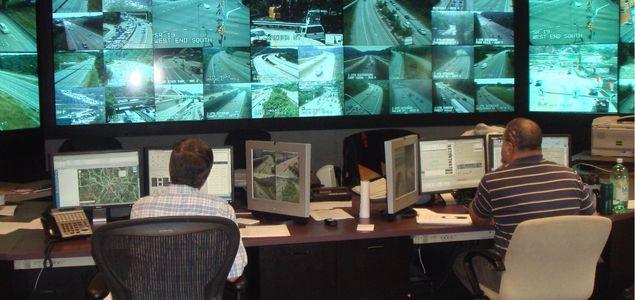
PennDOT is building on its commitment to ease traffic congestion through two innovations it championed as part of Federal Highway Administration's Every Day Counts Round 6 (EDC-6) – Crowdsourcing for Advancing Operations and Next Generation Traffic Incident Management (TIM): Integrating Technology, Data and Training.
PennDOT has produced software that relies on crowdsourced incident data from Waze and INRIX, two transportation mobile applications that provide traffic speed and incident data. The technology pulls together the speeds and incidents from a subset of vehicles on a given segment of roadway to provide real-time information, enabling PennDOT to create travel time messaging and increase roadway situational awareness. Traffic Management Centers (TMCs) are using the data coming from Waze and INRIX to get more detailed information on length of congestion and better understand what is occurring on roadways. This allows TMCs to post the information quickly and more accurately for queue protection and detouring and display it on the public-facing 511PA system.
Once an incident is cleared, residual congestion causes safety concerns and hundreds of secondary incidents each year. This means the traffic management job is not done until those queues are gone, and traffic is flowing normally again. PennDOT had to change this perception culturally and began approaching designing systems and TMC processes to focus on these scenarios about four years ago. Using data, PennDOT set out to define where in the queue these congestion-related incidents were occurring (see image below). The data showed that almost half of the incidents occur two or more miles from the source. This knowledge provides traffic operations staff with the opportunity to disseminate protection messages to approaching motorists. Originally, this was handled by staff monitoring existing TMC resources, but it was quickly determined that the ever-changing back of a queue is difficult to monitor with traditional TMC methods
PennDOT went back to their systems design and reevaluated existing datasets and developed the concept to use road segment speed data and built a "corridor" protection module for the Advanced Transportation Management System. In 2021, PennDOT piloted the first queue protection corridor using INRIX crowdsourced speed data in the nation. The system can dynamically calculate how far ahead the stopped or slow traffic is and post automatic data-driven messages to changeable message signs in predefined corridors. There are now approximately 20 queue and other data-driven protection corridors live today.
Next Generation TIM incorporates training, data, and technology to help PennDOT, the Pennsylvania Turnpike Commission (PTC), law enforcement officials and local agencies improve incident clearance times and reduce secondary crashes. The objective is to put reliable data behind the incident timeline to develop a data-driven 'incident influence time' measure of when traffic returns to historically normal speeds for that time of day.
To aid in this effort, online courses were developed with the help of the PTC to deliver traffic incident training to emergency management professionals across the state. PennDOT also entered into an agreement with the Maryland Department of Transportation to use a web-based video sharing platform called MView. This platform allows PennDOT traffic cameras to be shared with public agency incident management partners. PennDOT's more than 1,000 traffic cameras are now part of a multi-state system of more than 15,000 cameras that allow more than 200 participating agencies to have better situational awareness when incidents occur. PennDOT continues to build its network of partners with close to 1,000 users across Pennsylvania and is working with larger municipalities and major cities to bring their cameras into the system as well.
ABOUT THIS BLOG
Did you know PennDOT is directly responsible for nearly 40,000 miles of highway and roughly 25,000 bridges? We oversee programs and policies affecting highways, urban and rural public transportation, airports, railroads, ports and waterways, in addition to administering the state's more than 11 million vehicle registrations and 8.8 million driver's licenses.
So, how do we do what we do? And how can we help you travel in Pennsylvania — whether it be for business or leisure — in safe and enjoyable manner? Read PennDOT Way to learn more about the department, what we do, and how and why we do it.
TAGS
50-Year Anniversary, 511PA, Aggressive Driving, Airports, Autonomous Vehicles, Bicycles, Bridges, Child Safety, Community Relations, Construction, COVID-19, Distracted Driving, District 1, District 10, District 11, District 12, District 2, District 3, District 4, District 5, District 6, District 8, District 9, DOTcom, Driver and Vehicle Services, Emergency Responders, Employment, Equity, FAQ Friday, Human Trafficking, Impaired Driving, Innovations, Live Free Ride Alive, Maintenance Monday, Motorcycles, Older Drivers, PA Motorcycle Safety Program, Pedestrians, PennDOT Connects, Ports, Public Transit, Railroads, REAL ID, Road MaP, Roadside Beautification, Rural Roads, Safety, School Buses, Seat Belts, State Transportation Innovation Council (STIC), Sustainability, Teen Drivers, Throwback Thursday, Transportation Funding, Travel in PA, Welcome Centers, Winter, Work Smart, Work Zone, Yellow Dot
LATEST POSTS
PennDOT Continues Sharing, Updating Resources for Local Governments to Pursue Bipartisan Infrastructure Law Funding Opportunities
Norwin High School Wins 2024 ‘Innovations Challenge’
Demo Complete: I-95 CAP Project in Center City Philadelphia
PennDOT Archeologist Connects Past, Present, and Future
Lehigh Valley DUI, Highway Safety Task Force Hosts Law Enforcement Seminar
ARCHIVES
2024
2023
2022
2021
2020
2019
2018
2017

